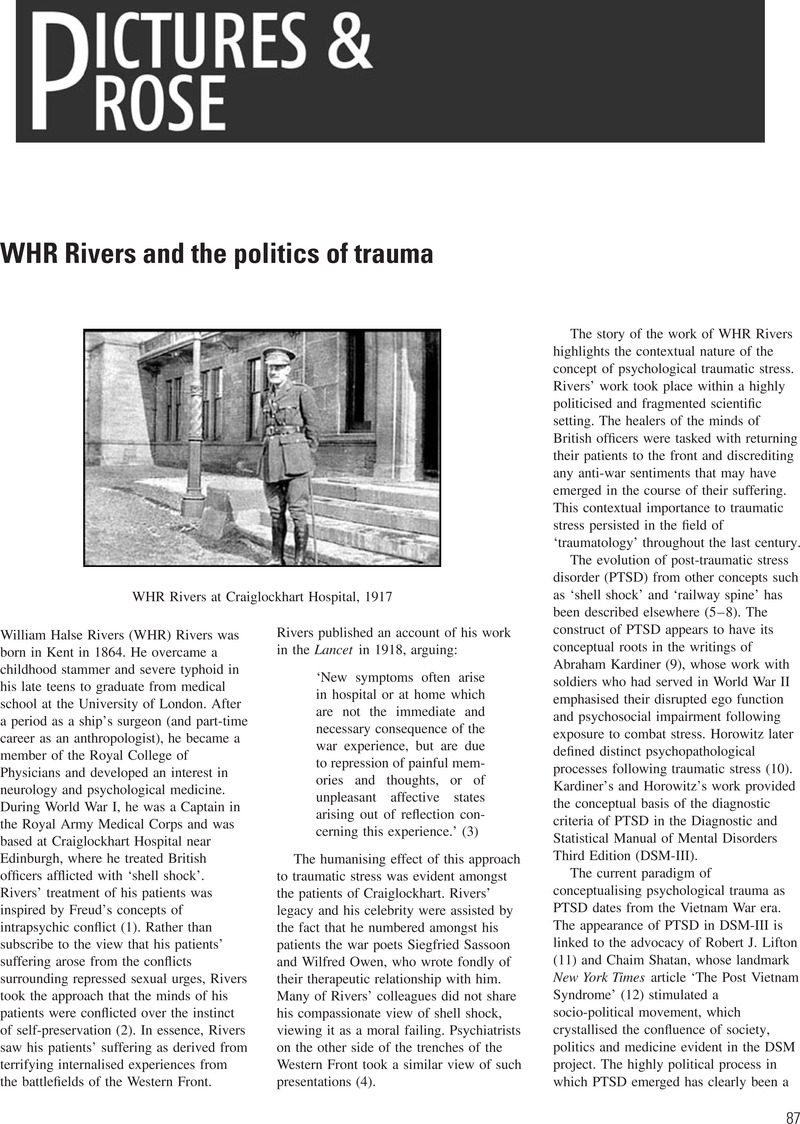No CrossRef data available.
Article contents
WHR Rivers and the politics of trauma
Published online by Cambridge University Press: 24 June 2014
Abstract
An abstract is not available for this content so a preview has been provided. Please use the Get access link above for information on how to access this content.

- Type
- Pictures & Prose
- Information
- Copyright
- Copyright © 2010 John Wiley & Sons A/S
References
Freud, S.Introduction to psychoanalysis and the war neurosis. In: Strachey, J, ed. Standard edition of the complete works of Sigmund Freud. London: Hogarth Press, 1955:205–210.
Google Scholar
Rivers, W.Instinct and the unconscious: a contribution to a biological theory of the psycho-neuroses. Cambridge: Cambridge University Press, 1920.
Google Scholar
Rivers, W.An address on the repression of war experience.
Lancet 1918; http://net.lib.byu.edu/~rdh7/wwi/comment/rivers.htm (accessed 12 Jan 2010).Google Scholar
Brunner, J.Will, desire and experience: etiology and ideology in the German and Austrian medical discourse on war neurosis 1914-1922.
Transcult Psychiatry 2000;37:1048–1060.
CrossRefGoogle Scholar
Shepherd, B.A war of nerves - soldiers and psychiatrists 1914-1994. London: Pimlico, 2002.
Google Scholar
Wilson, J.The historical evolution of PTSD diagnostic criteria: from Freud to DSM-IV. In: Everly, G,
Lating, J, eds. Psychotraumatology: key papers and core concepts in post-traumatic stress. New York: Plenum Press, 1995:9–26.
CrossRefGoogle Scholar
Young, A.The harmony of illusions: inventing post-traumatic stress disorder. Princeton: Princeton University Press, 1995.
Google Scholar
Young, A.When traumatic memory was a problem: on the historical antecedents of PTSD. In: Rosen, G, ed. Posttraumatic stress disorder: issues and controversies. Chichester: John Wiley and Sons, 2004:127–146.
CrossRefGoogle Scholar
Kardiner, A.The traumatic neurosis of war. Washington, DC: National Research Council, 1941.
CrossRefGoogle Scholar
Lifton, RJ.Advocacy and corruption in the healing professions.
Int Rev Psychoanal 1976;3:385–398.
Google Scholar
Erickson, K.Everything in its path: destruction of community in the Buffalo Creek flood. New York: Simon and Schuster, 1976.
Google Scholar
Ettinger, L.Organic and psychosomatic after effects of concentration camp imprisonment.
Int Psychiatry Clin 1971;8:205–215.
Google Scholar
Hoppe, K.Re-somatization of affects in survivors of persecution.
Int J Psychoanal 1968;49:324–326.
Google ScholarPubMed
Jaffe, R.Dissociative phenomena in former concentration camp inmates.
Int J Psychoanal 1968;49:310–312.
Google ScholarPubMed
Krystal, H.On some roots of creativity.
Psychiatr Clin North Am 1988;11:475–491.
Google ScholarPubMed
Young, A.Posttraumatic stress disorder of the virtual kind. In: Sarat, A,
Davidovitch, N,
Alberstein, M, eds. Trauma and memory - reading, healing and making law. Stanford: Stanford University Press, 2007:21–48.
Google Scholar
Jones, E,
Hodgins-Vermaas, R,
Everitt, B,
Beech, C,
Poynter, D,
Palmer, I.Post-combat syndromes from the Boer War to the Gulf War: a cluster analysis of their nature and attribution.
Brit Med J 2002;324:1–7.
CrossRefGoogle ScholarPubMed
Bloom, S.Our hearts and our hopes are turned to peace: origins of the International Society for Traumatic Stress Studies. 2005; http://www.istss.org/what/history.htm2006 [accessed on 12 January 2010].Google Scholar
Robertson, M,
Walter, G.Trauma and post traumatic stress disorder. In: Bloch, S,
Green, S, eds. Psychiatric ethics, 4th edn.Oxford: Oxford University Press, 2009:473–494.
CrossRefGoogle ScholarPubMed


